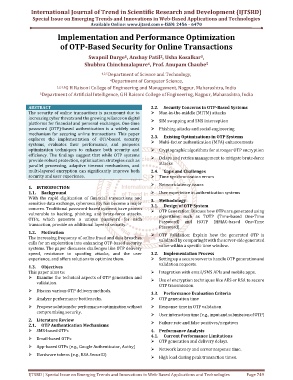Page 759 - Emerging Trends and Innovations in Web-Based Applications and Technologies
P. 759
International Journal of Trend in Scientific Research and Development (IJTSRD)
Special Issue on Emerging Trends and Innovations in Web-Based Applications and Technologies
Available Online: www.ijtsrd.com e-ISSN: 2456 – 6470
Implementation and Performance Optimization
of OTP-Based Security for Online Transactions
2
1
Swapnil Durge , Anshay Patil , Usha Kosalkar ,
3
Shubhra Chinchmalapure , Prof. Anupam Chaube
4
5
1,2,5 Department of Science and Technology,
4 Department of Computer Science,
1,2,4,5 G H Raisoni College of Engineering and Management, Nagpur, Maharashtra, India
3 Department of Artificial Intelligence, G H Raisoni College of Engineering, Nagpur, Maharashtra, India
ABSTRACT 2.2. Security Concerns in OTP-Based Systems
The security of online transactions is paramount due to Man-in-the-middle (MITM) attacks
increasing cyber threats and the growing reliance on digital
SIM swapping and SMS interception
platforms for financial and personal exchanges. One-time
password (OTP)-based authentication is a widely used Phishing attacks and social engineering
mechanism for securing online transactions. This paper
2.3. Existing Optimizations in OTP Systems
explores the implementation of OTP-based security
systems, evaluates their performance, and proposes Multi-factor authentication (MFA) enhancements
optimization techniques to enhance both security and Cryptographic algorithms for stronger OTP encryption
efficiency. The findings suggest that while OTP systems
Delays and retries management to mitigate brute-force
provide robust protection, optimization strategies such as
attacks
parallel processing, adaptive timeout mechanisms, and
multi-layered encryption can significantly improve both 2.4. Gaps and Challenges
security and user experience. Time synchronization errors
Network latency issues
1. INTRODUCTION
1.1. Background User experience in authentication systems
With the rapid digitization of financial transactions and 3. Methodology
sensitive data exchange, cybersecurity has become a major 3.1. Design of OTP System
concern. Traditional password-based systems have proven OTP Generation: Discuss how OTPs are generated using
vulnerable to hacking, phishing, and brute-force attacks. algorithms such as TOTP (Time-based One-Time
OTPs, which generate a unique password for each Password) and HOTP (HMAC-based One-Time
transaction, provide an additional layer of security.
Password).
1.2. Motivation OTP Validation: Explain how the generated OTP is
The increasing frequency of online fraud and data breaches validated by comparing it with the server-side generated
calls for an exploration into enhancing OTP-based security value within a specific time window.
systems. The paper discusses challenges like OTP delivery
speed, resistance to spoofing attacks, and the user 3.2. Implementation Process
experience, and offers solutions to optimize them. Setting up a secure server to handle OTP generation and
validation requests.
1.3. Objectives
This paper aims to: Integration with email/SMS APIs and mobile apps.
Examine the technical aspects of OTP generation and
Use of encryption techniques like AES or RSA to secure
validation.
OTP transmission.
Discuss various OTP delivery methods.
3.3. Performance Evaluation Criteria
Analyze performance bottlenecks. OTP generation time
Propose solutions for performance optimization without Response time in OTP validation
compromising security.
User interaction time (e.g., input and submission of OTP)
2. Literature Review
2.1. OTP Authentication Mechanisms Failure rate and false positives/negatives
SMS-based OTPs 4. Performance Analysis
4.1. Current Performance Limitations
Email-based OTPs
OTP generation and delivery delays.
App-based OTPs (e.g., Google Authenticator, Authy)
Network latency and server response time.
Hardware tokens (e.g., RSA SecurID)
High load during peak transaction times.
IJTSRD | Special Issue on Emerging Trends and Innovations in Web-Based Applications and Technologies Page 749

